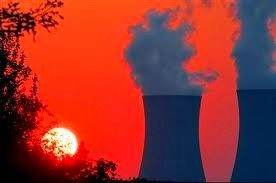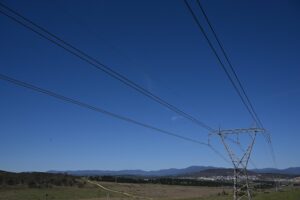Michael Goldsworthy is not the only one who has been betting the house on nuclear beating renewables to be the low carbon energy source of the future.
 Last month, Goldsworthy announced that the ASX-listed Silex Systems would look to jettison its solar assets and focus instead on its uranium laser enrichment technology, confident that the global nuclear industry would rebound and that his technology would be worth billions within a decade.
Last month, Goldsworthy announced that the ASX-listed Silex Systems would look to jettison its solar assets and focus instead on its uranium laser enrichment technology, confident that the global nuclear industry would rebound and that his technology would be worth billions within a decade.
Now its partners, GE and Hitachi, have dashed the plans by suspending all work on the nuclear technology. Two of the world’s biggest suppliers to the nuclear industry no longer have faith in the industry. Silex shares crashed in response.
The Tony Abbott government, it seems, is prepared to do exactly the same – jettison the country’s renewable energy industry and achievements in favour of a belief that the centralised form of generation will remain dominant for decades to come – and that nuclear will one day be the answer.
Numerous studies suggest that this is nonsense, that the emergence of solar, storage and software solutions will results in at least half the world’s electricity generated (and stored) “on site”.
But the conservative side of politics doesn’t want to know. It wants to extend the life of fossil fuel generators, pursue various of forms of emission reduction technologies for coal generators through its Direct Action plan, and leave the door open for nuclear.
The nuclear option is as yet unstated by the Abbott government, but you don’t have to scratch far beneath the surface to reveal a deep-seated belief in nuclear energy.
Abbott has surrounded himself with nuclear advocates. Most significantly, the man he appointed to adjudge the fate of the renewable energy target, and the wind and solar industries in Australia, climate change denier Dick Warburton, is convinced that nuclear is the only alternative to coal.
In an opinion piece he co-wrote for Quadrant magazine in 2011, Warburton wrote:
“Except for nuclear power, there are no straightforward strategies for reducing dependence on fossil fuels without large economic costs. Wind and solar generators often cannot function when needed.”
Others in Abbott’s orbit of business advisors share similar views. So do many of his cabinet colleagues and backbenchers, Industry minister Ian Macfarlane has explicitly written in nuclear as a consideration for the upcoming energy white paper.
In an issues paper released last December, Macfarlane’s team wrote that nuclear technologies continue “to present an option for future reliable energy that can be readily dispatched into the market.”
It also says: “A growing area of global interest is in the use of small modular reactors, which have the potential to reduce the cost uncertainties and construction timeframes associated with current generation reactor designs.”
The conservative commentariat is full of references to nuclear as a potential solution to safe-guarding Australia’s cheap energy status
Adam Creighton, the Australian’s economics writer, typified the confusion of conservatives about energy choices in his column last month, entitled “The wrong call on energy costs.”
Creighton – prompted by analyses commissioned by the anti-green energy Australian Chamber of Commerce and Industry, and BAE Economics, the private firm of RET Review panel member Brian Fisher – concluded that the renewable energy target was ineffective -“because it mandates a particular set of technologies (mainly wind), it stops use of much cheaper but non-renewable energy sources, such as gas, that are less carbon intensive.
And therein lies one of the problems – utter confusion and ignorance.
Gas is not both “cheaper and less carbon intensive”. It might be less carbon intensive than coal, but it is about twice the price, and could rise to three times the price as the LNG export boom takes hold. Hence the effective closure of all baseload gas plants in the country (they are now used as peakers only – and this has nothing to do with the renewable target).
Gas is certainly not less carbon intensive than renewables, and because of the soaring price for its fuel it is even questionable how much longer gas will remain cheaper than renewables. In the US, investors have decided to switch from new gas plants to solar – they simply don’t want to take the risk on variable fuel costs.
Indeed, as Citibank pointed out last year, the future of gas might rely entirely on being able to act as a “fast response” generation source in a high renewables grid.
Creighton the concluded with this revelatory pearler:
“Indeed, owners of black and brown coal power plants should be encouraged to bid for the ERF (emissions reduction fund) to help start construction of a commercial-scale nuclear reactor. Such a facility ultimately would contribute massively to carbon abatement and also encourage development of a skilled workforce. With near 40 per cent of the world’s uranium reserves and a significant quotient of isolated, uninhabitable land in which to store nuclear waste we are perfectly placed to shift towards nuclear energy, which already supplies 15 per cent of the rich world’s power supply.”
Hooray, problem solved.
But the idea is laughable for a bunch of reasons. First of all, there is not a single company in Australia, let alone a power plant operator, that has the balance sheet to carry the risk associated with a nuclear reactor. It is debatable whether Australia has a big enough economy to do so.
The second is the idea that nuclear is cheap. France is often held out as the prime example of this, but this façade is rapidly fading on the realisation that France will have to spend more in coming years on maintenance than it did on building the plants in the first place. (See graph at the end of story).
France’s Cour des Comptes said in a recent report that the current cost of production for France’s nuclear fleet was EUR 59.8/MWh ($A85/MWh), and will rise as the state-owned EdF invests another EUR 62.5 billion between 2011 and 2025, half of it just on safety measures. That cost will soar to EUR90 billion by 2033.
A Greenpeace report suggested that the safety upgrades needed for France’s 58 nuclear reactors would raise median production costs to 133 euros ($US180) per megawatt-hour (MWh) by 2020.
That estimate, based on an extension of the lifespan of current reactors by 10 years to 50 years and 4.4 billion euros worth of work per reactor, would make nuclear energy less competitive than onshore wind power around 2015, and less competitive than solar by 2020.
A parliamentary committee said the rising cost of France’s nuclear energy is of such a concern and the government should set up independent expert institutions to help it plan long-term energy investments. The Hollande government has already made a decision, to place a cap on nuclear capacity and ramp up the introduction of renewables, because they see it as the cheaper option.
In the UK, the $24 billion Hinkley C facility is to be built by EdF and some Chinese contractors after getting a guaranteed price of £92.50/MWh 0 nearly double the current average cost of generation in the UK – and a whole heap of subsidies.
As Deutsche Bank pointed out after that contract announcement, EdF effectively handballed the risk of new nuclear to the consumer and the UK government, and Deutsche wondered how the French government could possibly finance any investment in new reactors. Given that EdF is already cash-flow negative and has such a huge debt, few people have any clue how that could possibly be done.
In Australia, the Abbott government and the conservatives are completely blind to this. Hence their determination stop renewables as if it were part of some subversive green-left agenda. But the longer they delay renewables, the more they risk Australia’s economic indicators following in the path of Silex









